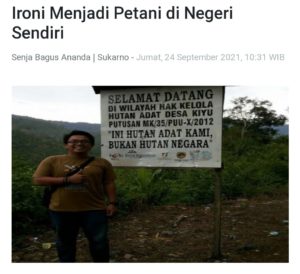In the past week, several newspapers were adorned with news related to village heads doubling as farmers who were suspected of producing and distributing seeds illegally. It reminds me of the many sad stories experienced by our farmers, ranging from difficulties in determining the prices of harvested commodities because they were already set by brokers or middlemen to the struggles many farmers in Indonesia face in accessing land due to the rampant land grabbing through various means.
Indeed, it is ironic that our country has long been known as an agrarian nation with superior commodities coveted by many colonial powers. Coupled with memories of the legendary band “Koes Ploes” singing that Indonesia is a rich country where even a stick can become a plant. Perhaps that is just a memory now, as being a small-scale farmer still prevalent throughout the country is very concerning
Destructive Green Revolution
The incident involving Mr. Munirwan in Aceh reminds me of the history of the world’s food that gave birth to the concept of the “Green Revolution.” The concept of the “Green Revolution” championed by William S. Eaud in 1968 had a significant impact in Indonesia. The Indonesian government packaged this Green Revolution concept under the title “Panca Usaha Tani” which was heavily criticized by many. Panca Usaha Tani emphasizes efforts in the rigid extensification and intensification of agriculture, with the rigidity stemming from the obligation for every farmer to plant crops instructed by the government (Mubyarto, 1979).
The policy of standardizing crops has implications on the reduction of local seeds and seedlings in Indonesia. Yet, this country owns numerous seeds and seedlings of various plant models and types. Indirectly, this eliminates the wealth of resources that should rightfully belong to this nation. An interesting example found in West Kalimantan, precisely in one village in Melawi Regency.
In 1983, this village in Melawi Regency received seedlings and seeds along with the creation of a 13-hectare rice field as part of the Corporate Social Responsibility (CSR) from one of the companies holding an IUPHHK-HTI. With the existence of the rice fields, the community practically transitioned from slash-and-burn farming to paddy farming. Of course, the community needed to be educated on paddy farming systems and the use of chemical fertilizers, as most of the residents were Dayak people whose tradition involved slash-and-burn farming and using natural fertilizers produced from burning before planting. Furthermore, the community was provided with rice seedlings named “Cimandiri” given by the Agricultural Office Department there and is still used until now.
Since 1999, the income from the Cimandiri rice commodity began to decline, leading to a continuous decrease in production. This prompted some farmers who still preserved local seeds to return to planting using the slash-and-burn farming system. In early 2019, I had the opportunity to visit and inquire about the issues regarding the rice commodity by comparing the harvest yields of Cimandiri Rice with Badu Rice (local seeds). The results were astonishing, with a significant difference in the number of grains per stalk harvested, where Cimandiri yielded 30 grains per stalk while Badu yielded 150 grains per stalk.
The brief story above made me realize that the misguided criticism of the Panca Usaha Tani program can be proven, showing that standardizing crops or commodities is not appropriate in the context of Indonesian soil. Moreover, the Panca Usaha Tani program focusing on intensification and extensification efforts is one of the inappropriate aspects. Intensification emphasizing the use of chemical fertilizers leads to soil degradation, loss of fertility, and soil pollution (LIPI, 2008). On the other hand, extensification





0 Komentar
Tinggalkan Balasan